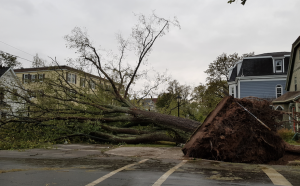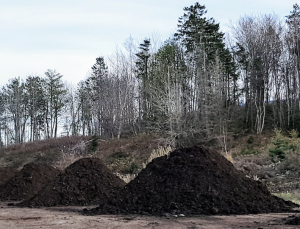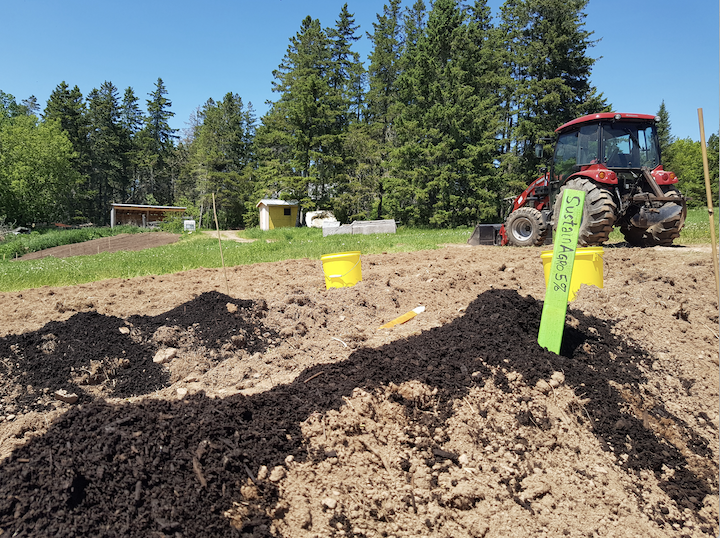By Joey O’Brien, ESRAG Director

Spring, 2023: SustainAgro field test of compost with biochar. Photo by Jon Schurman.
As a Rotarian and ESRAG board member I have become far more aware of the impending climate and food production crises that the world faces. I serve as CEO of SustainAgro, which is building Canada’s first pyrolysis facility to convert cellulose into low-carbon fuels, biochar, wood alcohol, and graphene. This process reduces solid waste, sustainably turning organic matter into products that can both sequester carbon and increase food security.
I have never been more engaged in the success of an enterprise, due to its potential to solve so many of society’s needs. While we have four products, this article is focused on biochar, which can restore the fertility of depleted agricultural soils. As the article Regeneration International explains, “soil degradation now threatens at least a third of the Earth’s land surface, and climate change is accelerating the rate of degradation. This is having a devastating impact on small farmers (who provide 70% of the world’s food supply) and on global food security.” Biochar also helps to mitigate climate change by sequestering carbon.
Our pyrolysis plant is on the Canadian province of Prince Edward Island (PEI), a small island off the east coast of North America. PEI produces many crops. Decades of high fertilizer usage have denuded the province’s agricultural soils of carbon. Rain-driven fertilizer runoff from these fields has resulted in blooms of “sea lettuce” in the estuaries, choking off local species. The island’s timber industry is also in serious decline.

View from Jon Schurman’s window in Charlottestown, PEI, the morning after Hurricane Fiona slammed the island.
PEI has one of the most aggressive climate action plans in North America. One of their priorities is to re-carbonize their agricultural soils. When SustainAgro determined PEI as the correct location for our first pyrolysis plant, we started working with a number of local sustainable farming groups. We are blessed with the quality and capability of the team members who have signed on to this effort. One of them is a young scientist, Jon Schuman. Continue reading for his report on the remarkable convergence of events – including the havoc created on the island by Hurricane Fiona in 2022 – that have made PEI an ideal place to test the agricultural use of biochar at scale.
Scaling up Biochar: Field Test on Prince Edward Island
by Jon Schurman, PhD
In confronting the need to increase food production while reducing chemical fertilizers and regenerating soil carbon, a growing number of climate-focused farmers are looking to biochar as the black gold of the 21st century. Produced by charring biomass down into dusty black granules of carbon, biochar has been an unintentionally well-kept secret among hobby farm aficionados and compost connoisseurs for decades. Spurred by tales of bountiful vegetation populating charcoal-enriched patches of Amazonian dark earth, home garden revolutionaries have been enthusiastically charring yard waste in backyard kilns since the ‘90s, all with little emphasis on upscaling. However, with a recent surge in demand for higher-quality carbon credits, biochar producers are generating excitement around the prospect of providing carbon dioxide removal services while converting biowaste into a climate-healthy farm product. As a result, a future powered by carbon-negative bioenergy could be within reach much sooner than many long-time biochar believers ever deemed possible.
Biochar and Bioenergy: Biochar has played a major role in positioning bioenergy as a leading player in our global energy transition. Our focus feedstock is on lignocellulosic material, which includes just about any plant material, such as wood, straw, peanut shells, etc. However, anything organic can be pyrolysed. Some operations pyrolyze carcases, manure, biosolids from municipal waste. These all produce biochars with extremely different characteristics.
Numerous industrial and natural processes generate stockpiles of biomass which previously had no commercial application. This material simply decomposes, releasing carbon dioxide to the atmosphere without generating value. However, a growing number of bioenergy production systems are now available to lock a sizeable portion of this carbon into biochar while refining the higher energy fraction of these biogenic feedstocks into drop-in fuels, such as hydrogenated renewable diesel.
One way to accomplish this is through a thermochemical reaction called pyrolysis, where biomass, exposed to high temperatures without oxygen, breaks down, releasing energy-rich gases and liquids and retaining carbon-rich biochar. The climate benefits of pyrolytic systems are substantially higher than conventional bioenergy systems which release 100% percent of the feedstock carbon back to the atmosphere. Pyrolytic systems that secure carbon as biochar lead to a net positive energy yield and a net negative carbon footprint. Producing carbon negative fuels thus greatly complements efforts to produce renewable electricity from wind and solar.
Renewable fuels are critical in the short-term window where rapid climate action is needed, because only about 20% of the world’s total power consumption is electric. Renewable fuels are thus available to decarbonize our existing infrastructure. As a larger portion of our energy use gets electrified, renewable fuels will be there for systems likely to resist electrification for decades to come, such as air travel.
Biochar Applications: A remaining hurdle to widespread upscaling of biochar as a mainstream climate change antidote involves finding cost-effective applications for it. One of the most fascinating characteristics of biochar is its extremely high surface area. Pyrolysis crystalizes the microporous structure of plant material into a carbon lattice that can last for millennia in soils. Incredibly, a sugar-cube sized piece of this crystal carbon lattice possesses hundreds of square meters of highly folded surface area. These micropores provide habitat for micro-organisms, promoting microbial diversity, similar to the way coral reefs promote diversity over what would be an otherwise sandy ocean floor. These microbes help plants balance their nutrition, allowing plants to focus their energy on growth.
A second perk of biochar’s extremely porous nature lies in its utility as a nutrient sponge. Livestock and industrial food processing facilities often generate toxically-high concentrations of nutrients, which are challenging to repurpose and pose major environmental concerns. Effluent containment lagoons produce potent greenhouse gases, high moisture makes effluents difficult to compost, and spraying liquid manures on agricultural land leads to major losses as nitrogen vaporizes, generating excruciating odor for your efforts. However, using the absorptive capacity of biochar to bulk these effluents into slurries has shown promising results in mitigating all of these issues, converting this liquid burden into an untapped resource available for nutrient recycling. By stacking the values of waste valorization and nutrient recycling, biochar gets used multiple times before ending up in its long-term storage.
Biochar carries many benefits, especially in degraded soils, but transitioning from small batch backyard systems to industrial production has been a major challenge. High-capacity pyrolysis reactors are expensive, and when these systems are geared towards maximizing biochar output (capping out around 30% yield), biochar must inevitably carry a weighty price tag. More recent bioreactors that produce multiple products (e.g., fuel, heat, biochar) take some of the financial burden off of biochar sales. However, the primary (and quite recent) development with the potential to bring biochar prices down for larger scale agricultural trials has been the emergence of a market for premium-grade carbon dioxide removal credits. A growing number of corporations are making Net Zero commitments. They often prefer to pay more for crunchy, high-permanence carbon removal credits, considering these more valuable than an avoided emission credit, and out of fears of fraudulent activity in the domain of forest credits.
For biochar producers to access these premium carbon markets generally requires that biochar ends up in farmed soils (though dosing concrete with biochar has been generating parallel interest). All soils are unique, so a final thrust of R&D is needed in most agronomic contexts to demonstrate that biochar addresses the local challenges of farmers confronted with spiking fuel and fertilizer costs. All factors considered, the ideal location for booting up industrial biochar production would involve a location with an over-abundant supply of low-grade biomass and high demand for a soil carbon regeneration hack. Seeing this, a team of bioenergy entrepreneurs, farm-industry and sustainable forestry non-profits, and a few researchers have zeroed in on Canada’s smallest province to make this carbon negative vision a reality.
PEI – Big climate ambitions from Canada’s smallest province: Prince Edward Island, Canada’s smallest and most densely populated province, faces concurrent crises in its farming and forestry sectors. In agriculture, despite being Canada’s smallest province, PEI happens to be Canada’s largest potato producer. PEI’s sandy, well-drained soils are exceptional for potato production, but heavy till practices have taken a big toll on soil carbon stocks. The king potato on PEI (the Russet Burbank) is also a nitrogen pig, and with prices for synthetic nitrogen fertilizer doubling every few years, farmers are in desperate need of a hack to bulk-load soils with carbon and retain increasingly precious nitrogen.

Compost with biochar. Photo by Jon Schurman
Forestry is also in dire straits on PEI. With a comparably small degree of forest cover compared to other regions, the province has struggled to hold up a viable forestry industry. Much of the province’s forest cover has been neglected, with non-marketable timber species growing in the sites of cut-and-run operations, and a general trend of deforestation as a growing number of Canadians look to the Atlantic region for their first, or often second, home. Based on the province’s most recent forest inventory data, approximately 75% of the standing timber crop is of insufficient grade for lumber production. That positions bioenergy as a savior for PEI’s forestry sector.
With land-use managers being squeezed by a shrinking timber basin, increasing fuel and fertilizer costs, and growing concerns of an era of hyper-regulated climate policies lurking around the corner, it may have seemed that the situation was as bad as it could get. However, in the fall of 2022, Hurricane Fiona made landfall as the most severe tropical storm to hit the region in written record. The storm dealt an excruciating gut punch to PEI and its sustainable management goals. The photo is the view from my window in Charlottestown the morning after Fiona made landfall. Forests across the province were devastated: the storm leveled several million tons of biomass. We have to use it within 3 to 5 years before this wood loses any salvageable value.
Joining forces to scale up: SustainAgro, Sustainable Forest Alliance, EarthTech NC & COPC, Living Labs Now President of EarthTech Natural Capital, I got my first exposure to biochar in graduate school at the University of Toronto, testing biochar effects on soil and tree growth in Eastern Ontario as my doctoral research. After several years abroad studying the impact of climate change on wood production, I returned to Prince Edward Island and built relationships with several forestry and farm industry groups. Learning more about the state of PEI’s forests and meeting farmers and industry group who were deeply concerned over collapsing organic matter, I came to the lightbulb moment that PEI could be an ideal site for upscaling biochar production.
In spring of 2022, under guidance from SustainAgro’s President of Eastern Operations Scott Travers, a PEI native, the company looked to the Maritime provinces for deployment of their first pyrolytic renewable diesel facility. PEI is a small place, and people with shared interests have a way of bumping in to one another. After my inevitable first encounter with Travers, we realized immediately how complementary our work was. With access to sustainable feedstock supplies and expression of interest on behalf of early biochar adopters to work together on biochar R&D, that clinched the case for launching SustainAgro’s facility on PEI.
Early results and next steps: SustainAgro and the PEI Certified Organic Producers Cooperative (COPC) have been collaborating on biochar product development since November of 2022. In a trial conducted by Cardwell Farms Compost, located in Sussex New Brunswick, and managed by the COPC, biochar was blended at 1% and 5% concentrations with an array of manures, fish viscera and woodchips. Materials were allowed to compost over the following months and will be used this spring to evaluate the plant growth and greenhouse gas benefits of using biochar-enhanced compost, relative to normal compost and conventional fertilizers. Using over 500 cubic yards of biochar-enhanced compost, we believe this study to be the largest compost blending experiment conducted in Canada to date.
While plant growth data will not be available until the harvest season of 2023, initial results from monitoring compost over the winter indicate that biochar is living up to the brochures. The impact of plummeting temperatures in December and January is acutely affecting the control and low dose biochar composts. However, at high doses, temperatures remained high, indicating that a more resilient microbial population is enduring the fluctuations in weather and continuing with their metabolic labor.
The plot trials will then lead into a further round of larger-scale trials, with more emphasis on logistics and feasibility. The East Prince Agri-Environmental Association has recently been appointed as lead partner to the PEI chapter of Living Labs, a Pan-Canadian effort to facilitate the integration of climate-friendly farm tech into conventional agriculture. Greenhouse gas reduction and carbon sequestration are two of the leading research priorities of the multi-year effort. With PEI now swimming in more storm generated biomass than it knows what to do with, the prospect of an advanced biofuel and biochar production facility couldn’t come soon enough.
With these partners in place, PEI has stacked the odds of unlocking biochar’s potential as a soil amendment in its favor. PEI forest owners will similarly have grounds for a bit more optimism than the last few months have provided: uncertainty for those whose timber holdings have been absolutely devastated, and for those who fear that another serious storm may be coming around the corner sooner than many are comfortable with. Our project partners hope to present their collaboration as a case study for upscaling biochar, and leveraging the power of carbon markets to make lemonade out of climate calamity. After all, with climate change intensified events such as Hurricane Fiona only becoming more frequent with rising temperatures, it only makes sense to incorporate the climate change healing benefits of biochar into our recovery efforts.

